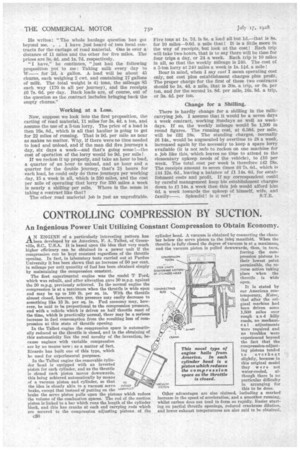CONTROLLING COMPRESSION BY SUCTION.
Page 52

If you've noticed an error in this article please click here to report it so we can fix it.
An Ingenious Power Unit Utilizing Constant Compression to Obtain Economy.
A N ENGINE of a particularly interesting pattern has 11..been developed by an American, F. A. Talbot, of Greenville, S.C., U.S.A. It is based upon the idea that very much higher efficiency can be obtained in a power unit if the compression can be kept constant regardless of the throttle opening. In fact, in laboratory tests carried out at Purdue University it has been shown that an increase of 50 per cent. in mileage per unit quantity of fuel has been obtained simply by maintaining the compression constant. The first experimental engine was the model T Ford, which was rebuilt, and after alteration gave 30 m.p.g.. against the 20 m.p.g. previously achieved. In the normal engine the compression is at a maximum when the throttle is wide open and may be up to 100 lb. per sq. in. With the throttle almost closed, however, this pressure may easily decrease to something like 15 lb. per sq. in. Fuel economy may, however, be said to be proportional to the compression pressure, and with a vehicle which is driven on half throttle most of the time, which is practically normal, there may be a serious increase in fuel consumption from the resulting loss of compression at this state of throttle opening.
In the Talbot engine the compression space is automatically reduced as the throttle is closed, and in the obtaining of this automaticity lies the real novelty of the invention, because engines with variable compression are by no means new ; as a matter of fact, Ricardo has built one of this type, which he -used for experimental purposes.
In the Talbot engine the removable cylinder head is equipped with an inverted piston for each cylinder, and as the throttle is closed each piston moves downwards, this being achieved automatically by means of a vacuum piston and cylinder, so that the idea is closely akin to a vacuum servo brake, except that instead of putting on the brake the servo piston pulls upon the pistons which reduce the volume of the combustion spaces. The rod of the suction piston is linked to a bar which runs the length of the cylinder block, and this has cranks at each end carrying rods which are secured to the compression adjusting pistons of the
TO IFSTA:CE MANIFOLD
cylinder head. A vacuum is obtained by connecting the chamber below the servo piston to the inlet manifold. When the throttle is fully closed the degree of vacuum is at a maximum, and the vacuum piston is pulled downwards, thus, in turn, forcing the compression pistons to their lowest point permissible, the re. verse action taking place when the throttle is wide open.
DOM PRPSSiON PISTON STOP WAITS DOWNWARD MOTION OF CYLINDER I-IEAD
It is stated By
RiDO our American contemporary, Motor, that after the original machine had been driven some 1,500 miles over rough and hilly roads, no mechanical adjustments SWAMwere required and no troubles were experienced beyond the fact that the .compression-adjust
ing pistons tended
engine hails from to over America. In each slightly, because in cylinder head is a this original model piston which reduces they w ere not the comp r e s sion water-cooled, al space as as the throttle though there is no is closed. particular difficulty
46. in arranging for this to be done. Other advantages are also claimed, including a marked increase in the speed of acceleration, and a smoother running, whilst carbon does not tend to form so rapidly. Easier starting on partial throttle openings, reduced crankcase dilution, and lower exhaust temperatures are also said to be obtained.
VACUUM PISTON












































































































